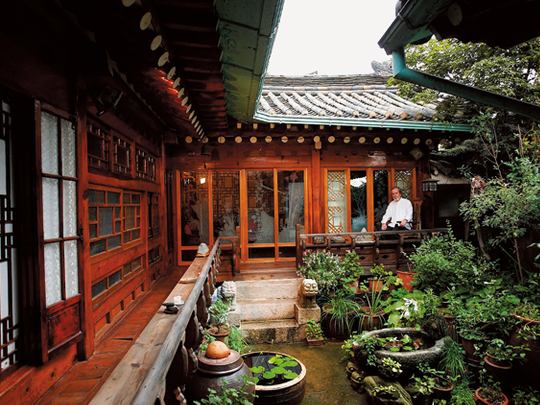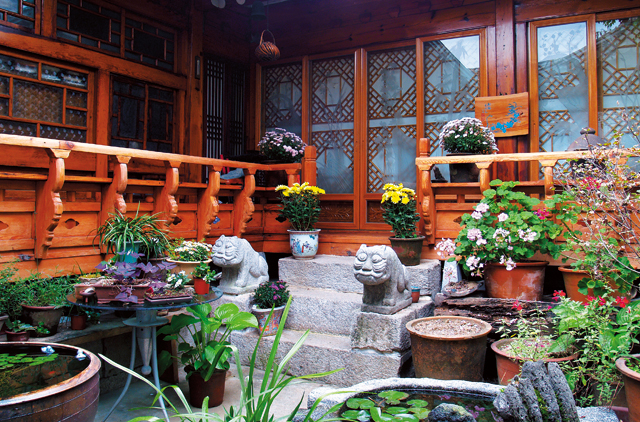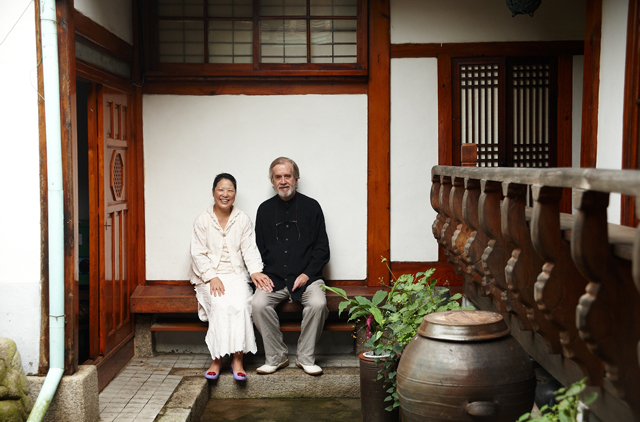
"We shape our buildings; thereafter they shape us."
Sir Winston Churchill's famous quotation which David Kilburn has posted on his website (www.kahoidong.com) succinctly underlines Kilburn's life mission: to preserve South Korea's traditional hanok houses.
It's a mission which began 22 years ago in Seoul, Korea, and one which Kilburn and his wife Keum Ok are keen to pursue as long as they can.
The beginnings
Once you leave behind the city of Seoul and travel past the modern steel and glass downtown areas, you will arrive at the foothills of the Pukkasan mountains. In the valley of these mountains lies the Gyeongbokgung Palace, the abode of the kings.
Rising up the foothills next to the palace is a cluster of black tiled houses, mostly single storey, built in the Korean traditional construction style known as hanoks. This neighbourhood is known as Kahoi Dong, (pronounced Gahoe-Dong), which loosely translated from Korean means ‘the place where beauty gathers'.
It is here that 67-year-old British-born David Kilburn and his wife Keum Ok have taken up residence - in a hanok he purchased some two decades ago.
"I never contemplated making Seoul or any other place a home ‘for the rest of my life'. I have always lived a very mobile life, and for decades have rarely been in the same place for much longer than a month.
During my years in advertising, I was travelling much of the time. As a journalist, I travelled widely in Asia," says Kilburn, when asked what made him decide on Seoul to settle down.
But it surely must have been the sheer beauty of the hanoks and in particular the Kahoi-Dong district, now declared a heritage zone, that attracted David and his Korean wife to buy a hanok there in 1988. They named it The House of Choi, after his wife Keum Ok whose family name is Choi. David's hanok is a precious reminder of times past. And no, David hastens to add, "the fact that Keum was Korean was not the reason we decided to buy a hanok in Seoul.''
Then what made him decide to buy a hanok and, more importantly, make it his mission to protect and preserve these ancient structures?
"[It's] just a... passion,'' says Kilburn.
"If you visit any of the older cities of Europe, you will find that the preservation of their heritage is something people consider sufficiently important to invest a great deal of time and money," he says. "[Also], the majority of hanoks are not dilapidated. There are hanoks that are around 200 years old and which still have their original timbers and roofs. In contrast, it is rare for the concrete apartment buildings of Seoul to have design lives longer than 25 years," David says.
What began as a one-man mission to prevent the destruction of hanoks in Seoul has now gathered pace. As numbers go he may not have achieved his goal. For example, in 1985 when the Hanok District City Plan was established there were 1,518 hanoks in Kahoi-Dong. Today the number stands at 800. But what Kilburn has done is create an awareness among the younger generation of Koreans on the critical role that heritage plays in "giving us both identity and values in a changing world".
David Kilburn's website www.kahoidong.com , launched as a single page in July 2005, is a treasure house of millions of megabytes on the endangered hanok architecture of Korea. It is a repository of video endorsements of the cause, video footage of destruction of hanoks, government documents recording the disappearing numbers of hanoks and media coverage on the issue. The website is one of the main tools David spearheads to further the cause of preservation of hanoks. With volunteers offering to translate the web pages into international languages this movement to preserve the hanok heritage seems to have taken on a momentum of its own
Early days
David was born in Widnes, an industrial town on the northern banks of the River Mersey, near Liverpool in the United Kingdom.
He and his sister grew up in Runcorn and some of his fondest memories were of going on school trips to Milan, Rome, the Vatican, Pompei, Naples... The splendour of the Renaissance monuments in Italy left a huge impact on him.
Around the same time David also became aware of the rich traditional architecture that he was surrounded by in his own neighbourhood. "My school at that time was in Chester, originally a fortified Roman town that still retained much of its original Roman walls. The school was founded in 1541 by King Henry VIII and was appropriately called The King's School," David explains.
There was a lot of history and culture associated with the area and David was happy to note that whenever town planners were considering projects to develop the area, there was never any doubt that the city's historical heritage was sacrosanct. "I guess I absorbed this ethos as a wholly proper way to manage things in a civil society. I also assumed that one day, I would be, along with all my contemporaries, holding all this in trust for the future, just as our predecessors had held it in trust for us. Why? Because it was part of who we were, part of our identities. I never imagined that it would be in South Korea, a country I had never heard of at that time, that these inherited beliefs would be seriously called into play."
After high school, David decided to study chemistry and natural sciences at the University of Birmingham. His main interests were cinema and journalism. After university, he moved to London and started work at an advertising agency, a job that took him to many countries in Europe, North and South America, Africa, the Middle East, and Asia.
"I was also working for an advertising agency in Dubai in 1981-82,'' he says. "I distinctly remember the Bastakiya, the creek, the Port of Jebel Ali, and the various construction projects.'' He remembers Dubai as a congenial, accommodating place to live as an expatriate.
David also travelled widely in the region: Saudi Arabia, Bahrain, Oman, Jordan, Egypt and Kuwait.
After moving on from the advertising agency, David joined an American magazine, which in 1987 commissioned him to do a few stories on South Korea. The Seoul Olympics were due the next year and they were keen to know what was happening there. "That was my first trip there and I ended up buying a hanok on the same visit," says David.
Kinds of hanoks
"There are many kinds of hanok. They are single-storey buildings made from natural materials, wood, stone, straw, paper, clay, etc. Typically, the main construction is a framework of interlocking wooden beams that form a three-dimensional rectangular shape. The main pillars stand on blocks of stone. The walls are traditionally made from mud and straw, though bricks are also used. Windows use paper, silk or glass. There are deep overhanging eaves, covered with ceramic tiles. (Seoul winters can go beyond -30C), so heating is by an "ondol" - a stone floor with a hypocaust beneath that is warmed by hot air from a fire or, more commonly today, hot water pipes connected to a central boiler.
"Following Confucian principles, the hanok has two major buildings - the men's quarters and the women's. A very large hanok will also have additional buildings for the servants, and for other purposes. Traditional hanoks were made by carpenters and wood craftsmen. The use of natural materials, the harmony of the design, and the hand-made feel of the building help to create a great sense of calm and peace,'' says David who writes for several publications and also runs a tea company called The Tea Museum, founded in 2001.
The building methods are fundamentally the same as those used to build the royal palaces of the Choson dynasty (1392-1910) as well as old Buddhist temples. (Hanok) styles have evolved through the five centuries of the Choson dynasty and now include some modern embellishments such as electricity, writes David in his article titled the House of Choi posted on his website www.kahoidong.com.
Public indifference
David cites public indifference and ignorance among the many reasons why hanoks have fallen by the wayside in the race to development. "Most young Koreans grow up in modern apartments, they attend school/college/ university in modern Western-style buildings and eventually they work in modern offices, factories, or whatever. Many of the unique features of Korean culture no longer have a part to play in their lives. When they travel abroad to Europe, for instance, they appreciate and value the cultural heritage that is preserved in Europe's old cities, but don't see any connection between that experience and the need to preserve their own cultural heritage.''
Among older people, hanoks are often associated with a difficult period both in their own lives and for South Korea as a whole. Following the Korean War, South Korea was a destitute, impoverished agricultural society. The country's absolute priority was economic growth and the building of a modern industrialised economy.
David's commitment to preserve the hanok heritage has extended to allowing his own house being featured in the award-winning Korean film Bin Jip. The official English name for the film is 3-Iron.
In 2006, David was attacked in the street by the man in charge of a building site opposite his own hanok. "He had illegally demolished a hanok and we complained to the authorities who sent an inspector to check what was happening.
"We were there to see what was happening, when the man lashed out at me. I spent a month in hospital thereafter.
"The attack exacerbated some problems I have from injuries suffered in a car accident many years ago. Incidentally, the inspector ruled that the demolition was indeed illegal and stopped the work.
"I also suffer from glaucoma and have very little vision left in my right eye. My left eye is also affected but, for the moment at least, is working sufficiently well. Mere illness is not a reason for abandoning something important,'' he says.
Q & A with David Kilburn
You have earned the nickname the ‘Guardian of Hanok Housing'. Can you outline some of the steps you took to create awareness and stop the destruction of hanoks?
Primarily via my website, www.kahoidong.com but also through media interviews, public lectures, and events. My Youtube channel (http://www.youtube.com/user/kilburnda) and Blog (Hanok Eyes - www.kahoidong.com/blog ) also play important roles.
The website began as a one page essay in 2005. Today, there are over 2,000 pages of documentation, over 50 videos, and hundreds of photographs. Parts of the website have been translated into Italian, French, German, Spanish, and Portuguese. Volunteers are also working on translations into Russian, the Scandinavian languages, Japanese. The translations began when a young Italian contacted me earlier this year and offered to translate into Italian. The appearance of some pages in Italian prompted people elsewhere to volunteer to help. The translators all share a point of view: that the destruction of a country's unique heritage is a tragic event that must be protested.
What has been the response to your work?
Only this year has public support begun to materialise in Korea, and mainly among young people.
Despite your activism it is said that hundreds of hanoks have been razed to make way for high-rise condominiums...
There are no numbers for how many hanoks there were or are in Korea.
In my own district, (Kahoi-Dong district 31) according to the city government there were 1,518 hanoks in 1985. Today there are fewer than 800. This district was the last in Seoul where you could see a few complete streets lined only with hanoks, looking much as they did almost a century ago. The district has changed from one in which hanoks and traditional architecture predominated to one in which modern buildings of all kinds predominate.
What strategies do you use to infuse momentum in this battle to preserve hanok heritage?
Last year, we held some art exhibitions, this year we hosted a series of free concerts of traditional Korean music, and also began a project creating videos of ordinary people talking about hanoks.
All of these initiatives also create further online content for the website, this gives them a life and a relevance that goes beyond the people who may attend or become involved.
Do you know of an individual, a group of people, a company or an organisation that is striving to make this world a better place? Every responsible, selfless act, however small or big, makes a difference. Write to Friday and tell us who these people are and what they do. We will bring you their stories in our weekly series, Making A Difference. You can email us at friday@gulfnews.com or to the pages editor at araj@gulfnews.com













